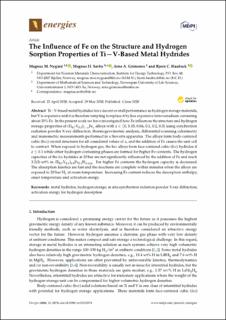| dc.description.abstract | Ti-V-based metal hydrides have decent overall performance as hydrogen storage materials, but V is expensive and it is therefore tempting to replace it by less expensive ferrovanadium containing about 20% Fe. In the present work we have investigated how Fe influences the structure and hydrogen storage properties of (Ti0.7V0.3)1−zFez alloys with errortypecez∈{0, 0.03, 0.06, 0.1, 0.2, 0.3} using synchrotron radiation powder X-ray diffraction, thermogravimetric analysis, differential scanning calorimetry and manometric measurements performed in a Sieverts apparatus. The alloys form body-centered cubic (bcc) crystal structures for all considered values of z, and the addition of Fe causes the unit cell to contract. When exposed to hydrogen gas, the bcc alloys form face-centered cubic (fcc) hydrides if errortypecez≤0.1 while other hydrogen-containing phases are formed for higher Fe-contents. The hydrogen capacities of the fcc hydrides at 20 bar are not significantly influenced by the addition of Fe and reach 3.2(3) wt% in (Ti0.7V0.3)0.9Fe0.1H1.6(2). For higher Fe contents the hydrogen capacity is decreased. The absorption kinetics are fast and the reactions are complete within minutes when the alloys are exposed to 20 bar H2 at room temperature. Increasing Fe content reduces the desorption enthalpy, onset temperature and activation energy. | en_US |

